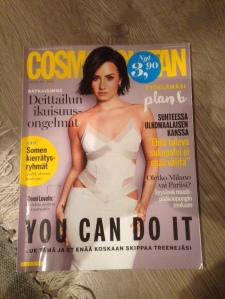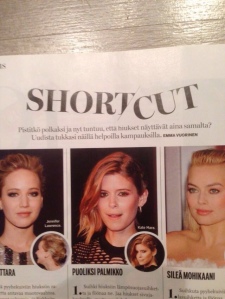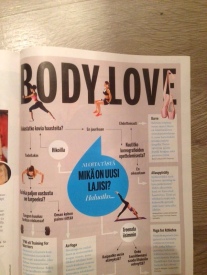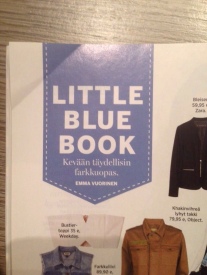

For our second essay we explored media environments, and after a brief brainstorming session we decided to scan through a few issues of Cosmopolitan, a widely popular women’s magazine published in over 30 countries all over the world. Although the main concept and themes are the same in every country, each has its own editor-in-chief and, for example, in Finland the main language is Finnish. However, even in our small-scale research, we found numerous occasions where English is used both regularly and randomly alongside Finnish. Our main objective was to examine the possible reasons behind choosing to use English instead of Finnish.

First, we figured that English is sometimes used purely for its expressive value. One of the issues featured an article which offered advice on how to style one’s short hair easily: the article was called Short cut. Here, the Finnish equivalents ”oikotie” or ”lyhyt leikkaus” would not have done a sufficient job in describing the idea of the article, while the English heading covers both of these meanings.



In addition to its expressive value, English was used regurarily with certain themes, such as fashion or fitness. Fitness as a theme attracted lots of familiar phrases, such as ”you can do it” or ”work it girl”. These could easily be translated into Finnish, but perhaps they were considered more inspirational and motivational in English. With fashion terms, such as ”camel coat”, however, translating might be a problem. ”Kamelitakki” does not work well at all, since ”camel” refers to the color, not the animal. The same problem arises if one tries to translate the term ”it” – for example, when the magazine talks about the next ”it-vauva” (it-baby). Finnish does not have an equivalent for it, and perhaps that is the reason why the term ”it-vauva” has experinced some mixing and matching of the two languages.
Some of these were rather clear solutions, but most of the cases were not that simple. English was used in bits and pieces here and there, even in reacurring section headlines. One, for example, carries the name Walk with me, and the idea is for someone to share their typical day with the readers of Cosmopolitan. The heading could be easily translated, but the editors have chosen not to do so. English seems to be gaining more and more ground in the magazine and the reasons behind the spread might be more complicated than just, for example, stylistic ones.
Cosmopolitan’s target audience are women aged 18 and up, and the magazine encourages women to be confident, independent and strong – to be ”cosmowomen”. The term is used regularly in the Finnish issues, also, and it might just be that the magazine wants to emphasize that the readers are a part of a large group of ”cosmowomen” all around the world. In some of the cases, though, one might wonder if there is a line to be drawn. Most Finns might understand the expression ”work it girl”, but some of the phrases and headings used might require more than just the basics.
